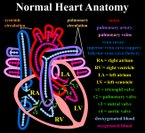Definition
Transposition of the great arteries is a birth defect causing a fatal condition in which there is a reversal, or switch, in the trunkal connections of the two main (great) blood vessels to the heart, the aorta and pulmonary artery.
Description
There are two great arteries, the pulmonary artery and the aorta. Normally, the pulmonary artery carries blood from the right ventricle to the lungs. The aorta carries blood from the left ventricle to the vessels of the rest of the body.
Normally, blood returning to the heart is depleted in oxygen. It goes first to the right atrium of the heart and then to the right ventricle where it is pumped through the lungs. While in the lungs, the blood picks up more oxygen. After the lungs, the blood flows to the left atrium, then the left ventricle, which pumps out through the aorta to the rest of the body, thereby supplying the body with oxygenated blood.
Transposition of the great arteries results in oxygen-depleted blood going to the body. The reason is that the connection of the two great arteries is reversed. In this case, the aorta is connected to the right ventricle. Blood returning to the heart goes to the right atrium and ventricle, which is normal. Then, when the right ventricle pumps the blood out, it goes into the aorta for distribution throughout the body. At the same time, blood in the lungs goes to the left atrium, the left ventricle, but then back to the lungs. This happens because the pulmonary artery is connected to the left ventricle. The result is that highly-oxygenated blood keeps recycling through the lungs, while oxygen-depleted blood recycles through the body without going through the lungs to reoxygenate.
This condition develops during the fetal stage and must be treated promptly after birth if the newborn is to survive. The newborn can survive for a few days because the foramen ovale, a small hole in the septum that separates the two atria, is open, allowing some oxygenated blood to escape and mix into the blood that is being pumped throughout the body. However, the foramen ovale normally closes within a few days after birth.
Causes & symptoms
Transposition of the great arteries is a birth defect that occurs during fetal development. There is no identifiable disease or cause. The main symptom is a "blue" baby appearance, caused by a general lack of oxygen in the body's tissues.
Diagnosis
Diagnosis is made immediately after birth, when it is observed that the newborn is lacking oxygen. This is noted by the bluish color of the newborn, indicating cyanosis, a lack of oxygen. A definite diagnosis is made by x ray, electrocardiography (ECG), and echocardiography.
Treatment
The only treatment for this condition is prompt heart surgery shortly after birth. In surgery, the two great arteries are reconnected to their proper destination. This restores the normal blood flow pattern. The coronary arteries are also reconnected, so that they can supply blood to the heart itself. A catheter may be used to maintain or enlarge the opening between the two atria until surgery can be performed.
Prognosis
Left untreated, this disease is fatal within the first weeks of life.
Prevention
Because there is no identifiable cause, there is no way to prevent this condition.
Further Reading
For Your Information
Books
- Alexander, R.W., R. C. Schlant, and V. Fuster, eds. The Heart, 9th ed. New York: McGraw-Hill, 1998.
- Berkow, Robert, ed. Merck Manual of Medical Information. Whitehouse Station, NJ: Merck Research Laboratories, 1997.
- Larsen, D.E., ed. Mayo Clinic Family Health Book. New York: William Morrow and Company, Inc., 1996.
Gale Encyclopedia of Medicine. Gale Research, 1999.



